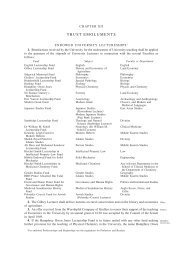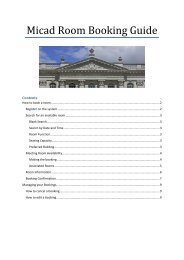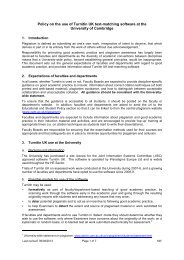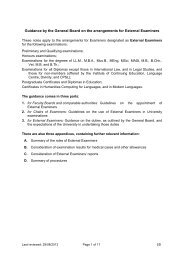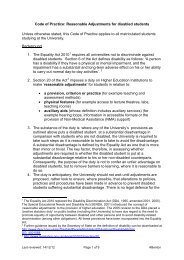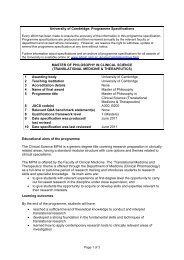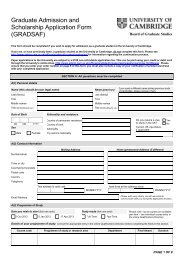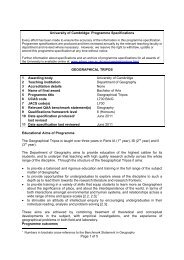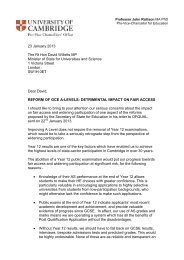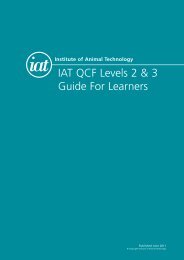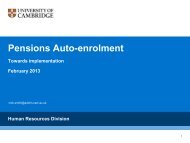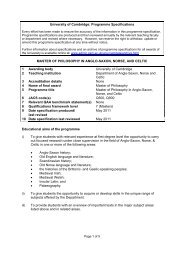Guidance Notes for Examination Question Papers - the University ...
Guidance Notes for Examination Question Papers - the University ...
Guidance Notes for Examination Question Papers - the University ...
You also want an ePaper? Increase the reach of your titles
YUMPU automatically turns print PDFs into web optimized ePapers that Google loves.
December 2012<br />
Page 1 of 8<br />
Board of <strong>Examination</strong>s<br />
<strong>Guidance</strong> notes <strong>for</strong> Faculties and Departments <strong>for</strong> <strong>the</strong> production of<br />
examination question papers 2012 / 13<br />
1 These notes relate to examination papers <strong>for</strong> <strong>the</strong> main examination period in Easter<br />
Term 2013. If you have examinations be<strong>for</strong>e <strong>the</strong> main examination period, please<br />
note that submission dates will be earlier. Please contact Ms Lyn Davis in <strong>the</strong> first<br />
instance to check <strong>the</strong> earlier submission date.<br />
Key in<strong>for</strong>mation<br />
2 In most cases, departments submit a camera ready copy of each question paper to<br />
<strong>the</strong> Reprographics Centre so that <strong>the</strong> Reprographics Centre can print multiple copies<br />
and prepare <strong>the</strong> examination packs. The deadline <strong>for</strong> submission of your camera<br />
ready copy to <strong>the</strong> Reprographics Centre is Friday 19 April 2013.<br />
3 A small number of departments request to see a proof of <strong>the</strong> printed examination<br />
paper be<strong>for</strong>e multiple copies are made. This is normally in <strong>the</strong> case of examination<br />
papers with a high number of symbols or accents or which contain detailed<br />
illustrations. If you intend to request a proof, <strong>the</strong> deadline <strong>for</strong> submission of your<br />
camera ready copy to <strong>the</strong> Reprographics Centre is Friday 5 April 2013. This<br />
earlier deadline is in order to allow time <strong>for</strong> any amendments to be made and<br />
checked.<br />
4 Very occasionally, a department prints its own multiple copies and <strong>the</strong>n submits<br />
<strong>the</strong>m all to <strong>the</strong> Reprographics Centre so that <strong>the</strong> Reprographics Centre may prepare<br />
<strong>the</strong> examination packs. The deadline <strong>for</strong> submission of your multiple copies to<br />
<strong>the</strong> Reprographics Centre is two weeks be<strong>for</strong>e <strong>the</strong> first of <strong>the</strong> examination<br />
papers.<br />
5 In a few cases, departments print <strong>the</strong>ir own multiple copies of each question paper<br />
and store <strong>the</strong>m securely in <strong>the</strong>ir own department. This applies to a small number of<br />
examinations which are held in departmental sites. In <strong>the</strong>se cases <strong>the</strong> department is<br />
responsible <strong>for</strong> all aspects of <strong>the</strong> quality and timing of <strong>the</strong> printing of <strong>the</strong> question<br />
papers, <strong>for</strong> <strong>the</strong>ir secure storage and <strong>for</strong> <strong>the</strong> correct preparation of <strong>the</strong> examination<br />
packs.<br />
Kate Allen<br />
November 2012
Security<br />
6 The initial preparation, editing and copying of question papers needs to be<br />
undertaken under strict confidentiality. All versions of draft and final copy must be<br />
typed, copied and stored securely. Ideally <strong>the</strong> computer(s) used to prepare and store<br />
<strong>the</strong> questions should not be connected to <strong>the</strong> <strong>University</strong> or any o<strong>the</strong>r network<br />
because of <strong>the</strong> danger of unauthorized access but this is not always practicable.<br />
Where a computer used <strong>for</strong> preparing exam questions is connected to a network it is<br />
essential that <strong>the</strong> risks are fully understood and steps taken to ensure that <strong>the</strong> overall<br />
level of risk is acceptable. The following paragraphs describe factors which should be<br />
considered when assessing <strong>the</strong> risks and some measures which can be taken to<br />
mitigate <strong>the</strong>se. If you do not fully understand <strong>the</strong> issues discussed below, it is<br />
essential that you consult someone who does eg a departmental Computer Officer or<br />
<strong>the</strong> <strong>University</strong> Computing Service, be<strong>for</strong>e using a networked computer to prepare<br />
exam papers.<br />
Understanding <strong>the</strong> Risk<br />
7 Be<strong>for</strong>e considering particular factors which may lead to security being<br />
compromised, it is important to realise that as well as <strong>the</strong> risk of unauthorized access<br />
<strong>the</strong>re is also <strong>the</strong> risk that such access will go completely undetected. This both<br />
highlights <strong>the</strong> need to reduce <strong>the</strong> risk of any unauthorised access occurring and to<br />
have mechanisms in place to control network traffic and record any suspicious<br />
activity.<br />
8 It is also important to consider <strong>the</strong> impact of unauthorised access. This is clearly<br />
higher <strong>for</strong> a whole paper than <strong>for</strong> a single question so, whilst it may be acceptable <strong>for</strong><br />
initial drafts of individual questions to be prepared on well secured networked<br />
computers, serious consideration should be given to having a dedicated nonnetworked<br />
computer <strong>for</strong> preparing <strong>the</strong> complete paper(s). This need not necessitate<br />
<strong>the</strong> purchase of an extra computer, instead an existing computer can be used with<br />
<strong>the</strong> operating system booted from a USB memory stick ra<strong>the</strong>r than <strong>the</strong> local disk<br />
drive eg Windows-To-Go or various versions of Linux. If this setup is used, access<br />
should not be enabled to ei<strong>the</strong>r <strong>the</strong> local disk drive or <strong>the</strong> network.<br />
9 A desktop computer is normally used ei<strong>the</strong>r <strong>for</strong> entirely local work or as a client <strong>for</strong><br />
services provided by o<strong>the</strong>r computers eg web servers. Used in this way, <strong>the</strong>re should<br />
be little risk of unauthorized access to material stored on <strong>the</strong> local disk drive but care<br />
must be taken not to use external storage, and especially not on servers outside <strong>the</strong><br />
<strong>University</strong>'s control. This applies both to <strong>the</strong> explicit storage of exam paper files but<br />
also to implicit copies taken as part of backups of <strong>the</strong> locally stored data. The risk of<br />
unauthorised access to files stored on <strong>the</strong> local disk drive may be fur<strong>the</strong>r mitigated if<br />
<strong>the</strong> time that <strong>the</strong>y remain on <strong>the</strong> disk is kept to minimum by transferring <strong>the</strong>m to some<br />
o<strong>the</strong>r medium eg USB memory stick or CD or DVD, which can be stored in a<br />
physically secure way. But note that simply deleting a file from <strong>the</strong> local disk does not<br />
necessarily delete <strong>the</strong> contents so care must still be taken to limit who has access to<br />
<strong>the</strong> disk. Note that <strong>the</strong>se problems can be avoided if <strong>the</strong> operating system is run from<br />
a USB memory stick as suggested above.<br />
Page 2 of 8<br />
Kate Allen<br />
November 2012
10 The risk is much greater, and potentially unacceptably high, if <strong>the</strong> computer itself<br />
provides any services. The firewall software on <strong>the</strong> computer should be configured to<br />
deny access to all such services and <strong>the</strong>se services should also be turned off<br />
wherever possible. One of <strong>the</strong> most likely to be enabled is file-sharing of files on <strong>the</strong><br />
local disk – this must be turned off. O<strong>the</strong>r common services include web servers and<br />
mechanisms to allow remote access to or maintenance of <strong>the</strong> computer – <strong>the</strong>se too<br />
must be turned off. As well as <strong>the</strong>se standard services, <strong>the</strong>re is a risk of unintended<br />
services being introduced by malware eg viruses and spyware. Particular care must<br />
<strong>the</strong>re<strong>for</strong>e be taken to ensure that <strong>the</strong> computer is free of such software by running<br />
fully up-to-date anti-virus software.<br />
Use of Email<br />
11 Exam questions must not be entrusted to unencrypted email which should be<br />
viewed in security terms as not dissimilar to sending it through <strong>the</strong> post printed on a<br />
postcard. Encryption can be used to reduce <strong>the</strong> risk to an acceptable level but it is<br />
important that <strong>the</strong> limitations of <strong>the</strong> method being used are clearly understood so that<br />
<strong>the</strong> residual risk can be properly assessed. This assessment should be made with<br />
<strong>the</strong> assumption that <strong>the</strong> message could fall into <strong>the</strong> wrong hands and that an attempt<br />
may be made to decrypt <strong>the</strong> contents especially if it is possible to guess from <strong>the</strong><br />
unencrypted part of <strong>the</strong> message that this may be worth <strong>the</strong> ef<strong>for</strong>t eg <strong>the</strong> subject is<br />
Computer Science Tripos Exam Paper. It is clearly important to be able to be sure<br />
that <strong>the</strong> risk of <strong>the</strong> key(s) leaking or being guessed is negligible.<br />
Printing and Paper Copies<br />
12 Great care should be taken when printing out exam papers and a locally attached,<br />
ie non-networked printer should normally be used. There are a number of risks with<br />
networked printers associated with transferring data over <strong>the</strong> network and <strong>the</strong> data<br />
<strong>the</strong>n being stored in <strong>the</strong> printer. Many printers hold of a copy of <strong>the</strong> print job until it<br />
has completed printing and, if a problem arises during printing eg a paper jam, it is<br />
very hard to delete <strong>the</strong> job and thus avoid <strong>the</strong> exam paper being printed later when<br />
<strong>the</strong> problem is cleared but <strong>the</strong> person trying to print it may no longer be around.<br />
13 Any print outs or notes associated with <strong>the</strong> content of question papers should be<br />
locked away securely and shredded once <strong>the</strong>y are no longer required. Any copies of<br />
<strong>the</strong> final paper, electronic or on paper, kept in <strong>the</strong> department or a faculty office must<br />
be stored securely eg in a locked filing cabinet in a secure room with restricted<br />
access.<br />
Page 3 of 8<br />
Kate Allen<br />
November 2012
Format of examination question papers<br />
14 All <strong>University</strong> examination papers are produced in A4 size, and to a standard<br />
style. Faculties and Departments are requested to con<strong>for</strong>m as closely as possible to<br />
<strong>the</strong> following guidance. A specimen question paper is attached <strong>for</strong> reference at<br />
Appendix A (p 8).<br />
15 The front page of <strong>the</strong> question paper is <strong>the</strong> definitive source of in<strong>for</strong>mation about<br />
what stationery and o<strong>the</strong>r material is required in <strong>the</strong> examination and this is used to<br />
set up <strong>for</strong> each examination. The Reprographics Centre, in preparing <strong>the</strong> examination<br />
packs, adheres strictly to whatever you have written on <strong>the</strong> question paper. Whatever<br />
is identified on <strong>the</strong> question paper will be supplied in <strong>the</strong> examination site. Anything<br />
not included on <strong>the</strong> question paper will not be provided on <strong>the</strong> day.<br />
16 The front page should contain <strong>the</strong> following:<br />
The subject code eg AAT1 or NST2CH<br />
The long description eg Archaeology and Anthropology Part 1<br />
Natural Sciences Part II Chemistry<br />
The paper code eg Paper A 16<br />
The paper title eg Medieval Poets<br />
Date and time of examination please refer to <strong>the</strong> examination timetable <strong>for</strong> this<br />
in<strong>for</strong>mation<br />
Rubric as necessary<br />
Stationery eg 8 page answer book x3; rough pad; graph paper<br />
Special requirements eg calculator, graph paper, data books<br />
Instruction: you may not start to read <strong>the</strong> questions printed on<br />
<strong>the</strong> subsequent pages of this question paper until<br />
instructed to do so<br />
17 It is recommended that <strong>the</strong> question paper uses a sans serif font <strong>for</strong> <strong>the</strong> purpose<br />
of improving accessibility.<br />
18 All papers containing more than 3 pages should carry <strong>the</strong> instruction<br />
(TURN OVER). This should be set in capitals on a new line after <strong>the</strong> last question on<br />
<strong>the</strong> third page and <strong>the</strong>n on subsequent right hand pages only. The front page<br />
containing <strong>the</strong> title and rubrics only (page 1) and <strong>the</strong> last page of <strong>the</strong> paper should<br />
not carry a turn over instruction.<br />
19 After <strong>the</strong> last question, <strong>the</strong> instruction END OF PAPER should appear in capitals<br />
centered on a new line.<br />
20 If a page deliberately does not have anything on it, please insert <strong>the</strong> in<strong>for</strong>mation<br />
THIS PAGE IS BLANK.<br />
Page 4 of 8<br />
Kate Allen<br />
November 2012
21 Signs and symbols, hand-written equations or simple diagrams must be of fine<br />
black ink lines. Ball-point pens are not suitable <strong>for</strong> reproduction.<br />
22 The total area covered by text must not exceed 6” x 9” / 150 mm x 230 mm. This<br />
includes diagrams, illustrations and extracts. O<strong>the</strong>rwise, text could be lost during<br />
production of <strong>the</strong> bound volumes of examination papers. A template showing <strong>the</strong><br />
position of <strong>the</strong> margins is available from Ms Lyn Davis lyn.davis@admin.cam.ac.uk<br />
23 Please ensure that all camera ready copy when submitted is marked lightly in<br />
pencil on <strong>the</strong> reverse showing:<br />
<strong>the</strong> Tripos title;<br />
<strong>the</strong> paper number and title; and<br />
<strong>the</strong> page number of each sheet.<br />
This will readily identify <strong>the</strong> correct paper and sequence of pagination within sets of<br />
papers.<br />
Stationery and special material requirements<br />
24 The front page of <strong>the</strong> question paper is <strong>the</strong> definitive source of in<strong>for</strong>mation about<br />
what stationery and o<strong>the</strong>r material is required in <strong>the</strong> examination and this is used to<br />
set up <strong>for</strong> each examination. Whatever is identified on <strong>the</strong> question paper will be<br />
supplied in <strong>the</strong> examination site including to individual students sitting in college,<br />
Titan or Pitt. The Reprographics Centre, in preparing <strong>the</strong> examination packs, adheres<br />
strictly to whatever you have written on <strong>the</strong> question paper. Anything not included on<br />
<strong>the</strong> question paper will not be provided on <strong>the</strong> day. If you have any queries please<br />
contact Ms Hea<strong>the</strong>r Kincaid hea<strong>the</strong>r.kincaid@admin.cam.ac.uk in Student<br />
Administration.<br />
Proof reading and <strong>the</strong> <strong>for</strong>mal approval of question papers<br />
25 All question papers must comply with <strong>the</strong> Form and Conduct Notice issued by <strong>the</strong><br />
Faculty. Any variation from this, <strong>for</strong> example in <strong>the</strong> content, scope and / or rubric of<br />
<strong>the</strong> question paper must have been <strong>for</strong>mally authorised by Education and Student<br />
Policy.<br />
26 <strong>Question</strong> papers should be thoroughly proof read and <strong>for</strong>mally approved prior to<br />
submission. The Board of Examiners may wish to delegate some aspects of <strong>the</strong><br />
detailed scrutiny of question papers but at least two designated examiners should be<br />
responsible <strong>for</strong> undertaking detailed proof-reading of <strong>the</strong> whole paper prior to<br />
finalising copy. The Chairman is responsible <strong>for</strong> determining an appropriate timetable<br />
<strong>for</strong> <strong>the</strong> submission of draft question papers so that examiners may consider and<br />
approve proposed question papers in time to comply with <strong>the</strong> deadline <strong>for</strong> submission<br />
to <strong>the</strong> Reprographics Centre.<br />
Page 5 of 8<br />
Kate Allen<br />
November 2012
Submission of examination question papers to <strong>the</strong> Reprographics Centre<br />
If you are submitting camera ready copy so that <strong>the</strong> Reprographics Centre can print<br />
multiple copies and prepare <strong>the</strong> examination packs<br />
27 The Chairman of Examiners (Senior Examiner <strong>for</strong> NST / MVST subjects) is<br />
responsible <strong>for</strong> taking <strong>the</strong> final camera ready copy of <strong>the</strong> examination paper(s), by<br />
hand, to <strong>the</strong> Reprographics Centre toge<strong>the</strong>r with <strong>the</strong> signed declaration confirming<br />
<strong>the</strong> accuracy of <strong>the</strong> paper. A receipt will be issued.<br />
The deadline <strong>for</strong> submission of your camera ready copy to <strong>the</strong> Reprographics<br />
Centre is 19 April 2013.<br />
If you are printing your own multiple copies and storing <strong>the</strong>m securely in your<br />
department<br />
28 The Chairman of Examiners (Senior Examiner <strong>for</strong> NST / MVST subjects) is<br />
responsible <strong>for</strong> taking ten copies of each question paper to <strong>the</strong> Reprographics<br />
Centre toge<strong>the</strong>r with <strong>the</strong> signed declaration confirming <strong>the</strong> accuracy of <strong>the</strong> paper. A<br />
receipt will be issued. These copies are required <strong>for</strong> any students who are examined<br />
in alternative sites eg Titan, Pitt or college; it is <strong>the</strong> Reprographics Centre which<br />
prepares <strong>the</strong>se individual student’s examination pack(s). These copies are also<br />
required <strong>for</strong> <strong>the</strong> bound volumes.<br />
29 The deadline <strong>for</strong> submission of your ten copies to <strong>the</strong> Reprographics Centre<br />
is two weeks be<strong>for</strong>e <strong>the</strong> first of <strong>the</strong> examination papers. This is to allow <strong>the</strong><br />
Reprographics Centre time to prepare <strong>the</strong> individual student packs <strong>for</strong> students sitting<br />
examinations in alternative sites.<br />
If you are printing your own multiple copies and submitting <strong>the</strong>m all to <strong>the</strong><br />
Reprographics Centre.<br />
30 The Chairman of Examiners (Senior Examiner <strong>for</strong> NST / MVST subjects) is<br />
responsible <strong>for</strong> taking all <strong>the</strong> examination question papers to <strong>the</strong> Reprographics<br />
Centre toge<strong>the</strong>r with <strong>the</strong> signed declaration confirming <strong>the</strong> accuracy of <strong>the</strong> paper. A<br />
receipt will be issued. They must be packaged in robust, sealed envelopes and<br />
should be labeled as follows:<br />
(i) a copy of <strong>the</strong> first page of <strong>the</strong> question paper should be displayed on <strong>the</strong><br />
outside of each envelope; this identifies <strong>the</strong> examination detail, <strong>the</strong> date and<br />
time of <strong>the</strong> examination and any stationery requirements; please refer to<br />
paragraph 16 (p 4) above <strong>for</strong> <strong>the</strong> in<strong>for</strong>mation required on <strong>the</strong> front page;<br />
(ii) write on each envelope <strong>the</strong> number of copies enclosed;<br />
(iii) write on each envelope <strong>the</strong> location of <strong>the</strong> examination eg Guildhall,<br />
Senate House.<br />
Page 6 of 8<br />
Kate Allen<br />
November 2012
31 The deadline <strong>for</strong> submission of your multiple copies to <strong>the</strong> Reprographics<br />
Centre is two weeks be<strong>for</strong>e <strong>the</strong> first of <strong>the</strong> examination papers. This is to allow<br />
<strong>the</strong> Reprographics Centre time to prepare <strong>the</strong> individual student packs <strong>for</strong> students<br />
sitting examinations in alternative sites.<br />
Publication of examination question papers<br />
32 Following <strong>the</strong> examination period, <strong>the</strong> Reprographics Centre will prepare <strong>the</strong><br />
bound volumes of examination papers.<br />
33 If you have exemption from publishing your papers in <strong>the</strong> bound volumes <strong>the</strong>n<br />
please mention this to <strong>the</strong> Reprographics Centre when you hand in <strong>the</strong> copies of your<br />
question papers or email Nigel Reynolds (Nigel.Reynolds@admin.cam.ac.uk). For<br />
enquiries about exemptions, please contact Kate Allen in <strong>the</strong> first instance<br />
kate.allen@admin.cam.ac.uk<br />
Any queries arising from <strong>the</strong>se guidance notes should be directed in <strong>the</strong> first instance<br />
to:<br />
Mrs L Davis<br />
4 Mill Lane<br />
Tel: (3)32296<br />
E-mail: Lyn.Davis@admin.cam.ac.uk<br />
Reprographics Centre<br />
The Old Schools Courtyard<br />
Monday to Friday, 8.30 a.m. to 12.45 p.m. and 2.15 p.m. to 4.45 p.m.<br />
Page 7 of 8<br />
Kate Allen<br />
November 2012
AAT1 1<br />
Archaeology and Anthropology Part I<br />
Sunday 31 February 2003 9 to 12.00 pm<br />
Paper A16<br />
Introduction to Anthropology<br />
You should answer five questions in total. Answer three questions from Section<br />
A and two more from Sections B and / or C.<br />
Answers from each Section must be written in a separate booklet.<br />
Booklets from each Section must be tied up in separate bundles, with <strong>the</strong> letter<br />
of <strong>the</strong> Section written on each cover-sheet.<br />
Write your number not your name on <strong>the</strong> cover sheet of each Section booklet.<br />
STATIONERY REQUIREMENTS<br />
8 page answer booklet x 3<br />
Rough Work Pad<br />
Graph Paper x 2 sheets<br />
SPECIAL REQUIREMENTS TO BE SUPPLIED FOR THIS EXAMINATION<br />
Calculator – students are permitted to bring an approved calculator<br />
Data Book (specify reference number or title or colour etc as necessary)<br />
Dictionary (specify reference number or title or colour etc as necessary)<br />
You may not start to read <strong>the</strong> questions printed on <strong>the</strong> subsequent pages<br />
of this question paper until instructed to do so.<br />
1 This is <strong>the</strong> Subject Code<br />
Page 8 of 8<br />
Appendix A<br />
Kate Allen<br />
November 2012



